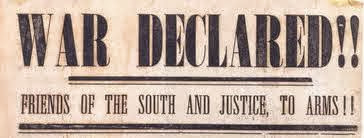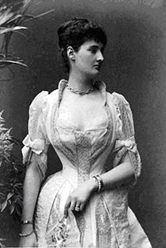*Pardon me for posting an article I used some time ago on another blog. I couldn't help thinking of this article and the book from which it's taken during our recent move. Again today my family and I were discussing the difficulty of our move. I recall being grateful we had moving vans and neatly staking boxes for our things. Here's the article:
Linda Hubalek has graciously allowed me to quote from her
book TRAIL OF THREAD, in which Dorothy Pieratt describes preparing for the trip
West from Kentucky to Kansas:
We debated, but finally packed two wagons for each family.
We felt it was better for the animals’ sake to limit the weight on each wagon
to around 2000 pounds instead of overloading one wagon....Since we need six
oxen per wagon, we bought extra animals a few weeks ago. John decided to use
oxen instead of mules because the oxen are easily managed, patient, and
gentle--even with the children--and not easily driven off or prone to
stampeding like mules and horses...After much discussion, John agreed to hitch
a cage of chickens on the back of the wagon.
Yesterday we sold everything that wouldn’t fit in the wagons
at a public auction on our farm. The strain of the day is still on my mind.
This morning I’ve been ready to fetch something and then I stop in midstep,
wondering if it’s tucked in the wagon or was sold yesterday. It was hard to see
most of the animals and all but a few chickens leave the place. But we can’t
take everything along, and we need the money. [*My family members are holding a giant garage/moving sale this spring.]

New wagon beds were built using seasoned oak boards. Sides
were jointed together. No nails were used that could work out along the bumpy
road and spell disaster. Along the inside of the three-foot-high sides, John
built long boxes running the length of the wagon for storage. These boxes will
serve as seats during the day if the children want to ride inside. We just add
boards cut to fit across the storage boxes, put bedding on top, and the wagon
is outfitted for sleeping. The boards fit in a wooden holder that runs along
the outside of the wagon. They can also be used to make a bench or table when
laid across stumps, or, heaven forbid, as lumber for a coffin.
I had a big hand in preparing the wagons, too. The wagon
beds were fitted with a framework of hickory bows high enough to give head
clearance, and I hand-sewed long pieces of cloth together for coverings. It was
quite an undertaking. It had to be tight, strong enough to withstand heavy
winds, and rainproof so things inside don’t get soaked. Even though it was
extra work, I ended up making them a double thickness to keep out the cold. A
dark muslin went over the framework first, then a heavy white linen. The dark
cloth cuts down on the brightness of the reflection as we walk beside the
wagon. I coated the outside material with a mixture of hot beeswax and linseed
oil for waterproofing. It turned the material a sand color, which should help
the reflection, too. The covering is drawn together on the ends by a strong
cord to form tight circles. End flaps an be buttoned on to completely seal the
wagon top. My stitches and buttonholes will be tested by the first storm we run
into. I even stitched pockets on the inside covering to hold little things like
our comb, sunbonnets, and other personal things I didn’t want out of reach.
John borrowed a guidebook to Oregon and California from a
neighbor, which suggested that for each adult going to California, a party
should carry 200 pounds of flour, 30 of hardtack, 75 of bacon, 10 of rice, 5 of
coffee, 2 of tea, 25 of sugar, 2 of saleratus, 10 of salt, a half-bushel each
of cornmeal, parched, and ground corn, and a small keg of vinegar. We’re not
going to California (unless the men change their minds), so we shouldn’t need
that much per person, but we’ll need supplies until we get crops and garden
planted and harvested. Who knows how long it will be until towns with stores
get established in the new territory?

I’ll take one barrel of pickled cucumbers along to prevent
scurvy...the decision of what kind and quality of item to trade for had to be
made...The mill sells different grades of flour. I wish I could have bought the
superfine flour, sifted several times...I bought the next grade, middlings, for
our cooking. It’s much more coarse and granular, but it serves the
purpose...The mill’s shorts, a cross between wheat bran and coarse whole wheat
flour, looked clean, so I also bought 125-pound sack of it... [* My husband loves pickles with a sandwich and now usually says, "Have to keep from getting scurvy" when he eats a pickle.]
We can’t afford to carry the flour in heavy barrels, so it
is mostly stacked in fifty-pound cotton cloth to cut down on weight. Because
the flour is not kiln-dried, we double-sacked it in a leather bag. If the
flower absorbs too much moisture, I’ll end up with a heavy loaf and will have
to add more flour to my baking.
Sorghum molasses, our main sweetener, will make the trip in
small wooden kegs...For special occasions, I bought three cones of white sugar.
The New Orleans sugar we buy reasonably in the stores her may fo for top dollar
on the frontier. The cones resemble pointed hats. They are molded atthe
factory, and wrapped in blue paper. Usually I leave the cones whole and use
sugar snippers, a cross between scissors and pliers, to break off lumps as I
need them. To save space on the trip, I ground up the cones and divided the two
types of sugar (the white sugar on the top gradually changes to brown sugar on
the bottom), then sifted to remove the impurities. The storekeeper said I
should pack it in India rubber sacks to keep it dry, but I decided not to add
that extra expense. I tucked the cone papers in the wagon because I can extract
the indigo dye from it to color yarn and material blue.
I also bought a small quantity of low grade brown sugar
since it is ten cents cheaper than the cones. It’s dark, smelly, sticky, and
sometimes dirty, but it still gives sweet taste to cooking.
Parched corn is another sacked commodity in the wagon. The
kernels were sun dried last fall and I’ll grind them into meal with the mortar
when I need it.
Smoked bacon was double-wrapped in cloth, put in wooden
boxes, and covered with bran to prevent the fat from melting during the trip. I
cooked the crocks of cut meat I had left into a thick jelly. After it set up in
pans and dried, we broke it into pieces and packed it in tins. If I add boiling
water to some, we’ll have portable soup on the trail.
Smaller sacks of beans, rice, salt, saleratus, and coffee
are wedged around the whiskey jugs underneath the wagon seat. The medicine box,
filled with tiny cloth sachets holding dried medicinal herbs and little
medicine bottles, is wedged on top, ready for an emergency.
I put the sacks of yeast cakes, dried bead, and hardtack inside
one of the long boxes, along with the box of homemade soap bars. I’ll have
small sacks of each staple in the back box and refill them from the bigger
sacks when I need to.
The back end of the wagon drops down partway on chains and
will serve as a preparation table for food or for other jobs. The provision box
faces the back so it can be opened up without hauling the box out of the wagon
every time. It has my tinware, cooking utensils and small sacks of necessities
for cooking everyday.
Wish I could have brought all my kitchen utensils, but I
settled for two spider skillets, three Dutch ovens of various sizes, the
reflector for baking, the coffee pot, the coffee mill, the mortar and pestle, a
few baking pans, knives, and my rolling pin.
Walking out to the wagons for the umpteenth time, it struck
me that they are starting to look like a peddler’s caravan. They are
overflowing with items attached to the sides. The wooden washtubs and zinc
washboard are fastened to one side of the wagon. The walking plow is lashed to
the other side. Small kegs of water, vinegar, and molasses fit in where needed
to balance the wagon. Everybody can see what we own because it’s hanging in
plain sight.
The second wagon is packed even tighter than the first with household
and farming tools we’ll need after we get to our new land. All the boxes are
packed tight so they won’t slide around, rattle, or spill. I hope we won’t have
to unpack it until we reach our destination.
Caroline Clemmons' latest release is THE MOST UNSUITABLE COURTSHIP, Kincaids, book 3, and is available in print and e-download from most online stores.
























